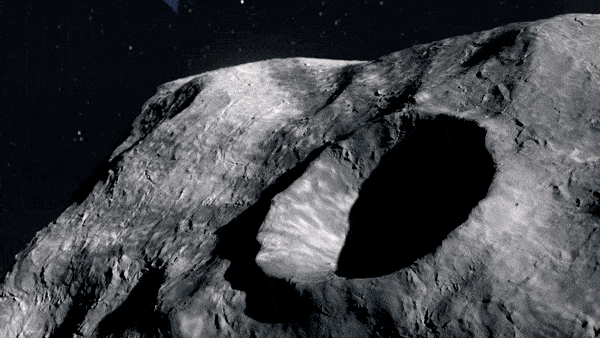
NASA and the European Space Agency (ESA) are teaming up for an ambitious mission to use a spacecraft to deflect an asteroid.
Researchers and engineers from the two agencies and beyond are meeting in Rome next week to discuss the idea, which they want to prove is a viable method of planetary defense.
The so-called Asteroid Impact Deflection Assessment (AIDA) would target the smaller body of the double Didymos asteroids orbiting between the Earth and Mars, with one spacecraft dedicated to knocking it off course and another to survey its remains once it crashes.

The main body of Didymos measures about 780 m across, and its smaller one measures about 160 m – slightly bigger than the Great Pyramid of Giza.
The smaller body only orbits the main body at a few centimetres per second, making the job of knocking it off course a feasible one.
NASA is providing the spacecraft for the first part of the job, and it is due to launch in the summer of 2021.
The DART (Double Asteroid Impact Test) craft is scheduled to collide with its target in September 2022, with the moment of impact to be recorded by an Italian-made miniature satellite along for the ride called LICIACube.
Close-up examination of whatever is left of the asteroid will be carried out by an ESA vessel called Hera, which will be able to measure its mass and the shape of the crater.
Hera will also deploy a pair of mini satellites of its own to carry out the very first radar probe of an asteroid, which could gather information about its terrain.

ESA’s Hera asteroid mission approaching the smaller Didymos asteroid. Pic: ESA
It is hoped that the results obtained by Hera would allow researchers to better model the efficiency of the collision, which could make the asteroid deflection technique a valid option in the event of a real threat.
Hera is not as far into its development as DART, with final design work still to be completed before it is approved at an upcoming ESA council conference in November.
Its launch would then take place in October 2024 and the journey to its destination would take about two years.
Ian Carnelli, manager of the Hera project, said: “DART can perform its mission without Hera – the effect of its impact on the asteroid’s orbit will be measurable using Earth ground-based observatories alone.
“But flying the two missions together will greatly magnify their overall knowledge return. Hera will in fact gather essential data to turn this one-off experiment into an asteroid deflection technique applicable to other asteroids.
“Hera will also be the first mission to rendezvous with a binary asteroid system, a mysterious class of object believed to make up around 15% of all known asteroids. “
Mr Carnelli added that the Hera mission would allow new deep space mini satellites – which are called CubeSats – to be tested, and provide the ESA with valuable experience of low-gravity operations.






GIPHY App Key not set. Please check settings